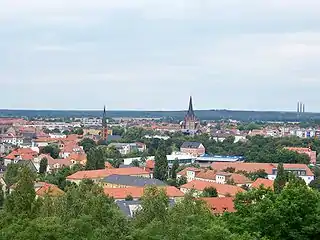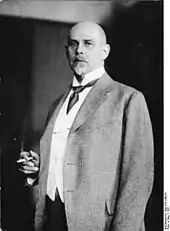Bitterfeld
Bitterfeld (German pronunciation: [ˈbɪtɐfɛlt]) is a town in the district Anhalt-Bitterfeld, Saxony-Anhalt, Germany. Since 1 July 2007 it has been part of the town Bitterfeld-Wolfen. It is situated approximately 25 km south of Dessau, and 30 km northeast of Halle (Saale). At the end of 2016, it had 40,964 inhabitants.[1]

History and description


The name Bitterfeld most likely comes from the Middle High German words bitter and Feld and so means "boggy land".[2]
Bitterfeld was built by a colony of Flemish immigrants in 1153. The first documentary mention is from 1224. It was captured by the landgrave of Meissen in 1476, and belonged thenceforth to Saxony, until it was ceded to Prussia in 1815.[3]
By 1900, Bitterfeld station was an important junction of the Berlin–Halle and the Magdeburg–Leipzig railways. The population at that time was 11,839; it manufactured drain-pipes, paper-roofing, and machinery, and had saw mills. There were also several coal mines in the vicinity. Owing to its pleasant situation and accessibility, it became a favoured residence of businessmen of Leipzig and Halle.[3]
During the East Germany (GDR) years, it gained notoriety for its chemical industry complex which caused remarkably severe pollution, even by GDR standards. On 24 April 1959 it also was a scene for the Bitterfeld Conference, locally known as the "Bitterfelder Weg". This conference sought to connect the working class with the artists of the day to form a socialist national culture.[4]
In the 21st century Bitterfeld is still an industrial town and it stages the annual United Metal Maniacs metal festival.[5]
The former brown-coal open cast mine of Goitzsche, south-east of Bitterfeld, is a source of numerous fossils in Bitterfeld amber.
 Catholic church
Catholic church Evangelical church
Evangelical church Villa am Bernsteinsee
Villa am Bernsteinsee Pegelturm tower in Goitzschesee lake
Pegelturm tower in Goitzschesee lake Vocational school center "August von Parseval"
Vocational school center "August von Parseval" Goitzschesee (lake)
Goitzschesee (lake)
Historical population
| Year | Population |
|---|---|
| 1840 | 4,649 |
| 1870 | 5,693 |
| 1880 | 6,531 |
| 1890 | 9,047 |
| 1925 | 18,384 |
| 1933 | 21,328 |
| 1939 | 23,949 |
| Year | Population |
|---|---|
| 1946 | 32,833[EW 1] |
| 1950 | 32,814[EW 2] |
| 1960 | 31,687 |
| 1981 | 22,199 |
| 1984 | 21,279 |
| 1990 | 18,099[EW 3] |
| 1995 | 16,868 |
| Year | Population |
|---|---|
| 2000 | 16,507 |
| 2001 | 16,237 |
| 2002 | 15,985 |
| 2003 | 15.798 |
| 2004 | 15,755 |
| 2005 | 15,728 |
| 2006 | 15,709[EW 4] |
(from 1840 to 2006):[6]

Sons and daughters of the town
- Johann Ernst Altenburg (1736-1801), trumpeter and organist
- Erwin Ding-Schuler (1912-1945), sturmbannführer and first camp doctor of Buchenwald
- Peter Rasym (born 1953), musician, has been playing bass guitar since 1997 with the Puhdys
Other personalities

- August von Parseval (1861-1942), his impact airships developed by him were partly built in Bitterfeld.
- Walther Rathenau (1867-1922), founder of Bitterfeld's chemical industry.
- Klaus Staeck (born 1938), graphic artist, lawyer and president of the academy of the arts, grew up in Bitterfeld.
Mayors
- 1851-1863 Gottlieb Meuche
- 1863-1873 Gustav Frischbier
- 1873-1890 Robert Sommer († 1890)
- 1890-1914 Hugo Hermann Adalbert Dippe (1853; † 1916)
- 1915-1927 Ernst Albert Hermann Schmidt
- 1927-1939 Arthur Erdmann Ebermann
- 1939-1945 Erhard Johann Martin Nimz
- 1943-1945 Walter Stieb (Interim)
- 26 April 1945 to 30 August 1945 Gustav Dietrich (deselection by Soviet city commandant) († 1972)
- September 1945 to 1946 Bernhard Moder
- 1946-1949 Ernst Rettel
- 1949-1950 Karl Salbach
- 1950-1953 Heinz-Rudolf Strauch
- 1953-1959 Wolfgang Stille
- 1959-1971 Else Petrushka
- 1971-1979 Max Dittbrenner
- 1979-1982 Karlheinz Sohr
- 1982-1990 Klaus Barth
- 1990-1994 Edelgard Kauf
- 1994-2007 Werner Rauball
- 2007-2009 Horst Tischer
- From 2010 Joachim Gülland
Literature
- Maron, Monika: Bitterfelder Bogen. Ein Bericht. Fischer Verlag, Frankfurt am Main 2009, ISBN 978-3-10-048828-2.
- Lojewsky, Hannelore: Seh’n wir uns nicht in dieser Welt, so seh’n wir uns in Bitterfeld. In: Norbert Kühne: Individuelles Lernen wird an Bedeutung gewinnen. 100 Jahre Hans-Böckler-Berufskolleg Marl/Haltern, Marl 2009, S. 29–30.
- Klaus Seehafer: Dann sehn wir uns in Bitterfeld. Tagebuch eines Jahres. Mitteldeutscher Verlag, Halle/S. 2009, ISBN 3-89812-664-1.
- Bitterfeld und das untere Muldetal. Edition no. 1 Böhlau, Cologne; Weimar; Vienna 2004, ISBN 3-412-03803-2 (Werte der deutschen Heimat. Vol. 66).
- Hackenholz, Dirk: Die elektrochemischen Werke in Bitterfeld 1914–1945. Ein Standort der IG-Farbenindustrie AG. LIT Verlag, Münster 2004, ISBN 3-8258-7656-X.
Notes
- 29 October
- 31 August
- 3 October
- 30 June
References
- Statistical information
- Mitteldeutsche Zeitung: Bitterfeld, ein Name, viele Geschichten
-
 This article incorporates text from a publication now in the public domain: Chisholm, Hugh, ed. (1911). "Bitterfeld". Encyclopædia Britannica. 4 (11th ed.). Cambridge University Press. p. 13.
This article incorporates text from a publication now in the public domain: Chisholm, Hugh, ed. (1911). "Bitterfeld". Encyclopædia Britannica. 4 (11th ed.). Cambridge University Press. p. 13. - "Bitterfelder Konferenzen", Kulturpolitisches Wörterbuch (2nd print ed.), Berlin: Dietz Verlag, 1978
- Festung Bitterfeld - 15 Jahre (1997-2012) (in German), retrieved 2013-01-18
- Data source since 1995: Statistisches Landesamt Sachsen-Anhalt
External links
| Wikimedia Commons has media related to Bitterfeld. |
- Stadt Bitterfeld-Wolfen, Stadt Bitterfeld-Wolfen - Wir haben den Bogen raus (in German), 51.656105;12.267308: Bitterfeld.de, retrieved 2013-01-18CS1 maint: location (link)
- Prochaska Online Service, Willkommen bei bitterfeld-online » Bitterfeld-Online (in German), 51.63;12.33: Bitterfeld-online.de, archived from the original on 2012-02-04, retrieved 2013-01-18CS1 maint: location (link)
- Der Pegelturm an der Goitzsche bei Bitterfeld (in German), Pegelturm.de, retrieved 2013-01-18
- Bandcommunity-bitterfeld.de (in German), Bandcommunity-bitterfeld.de, archived from the original on 2012-02-05, retrieved 2013-01-18
- Der Bitterfelder Bogen
- Bitterfeld at Curlie
.jpg.webp)